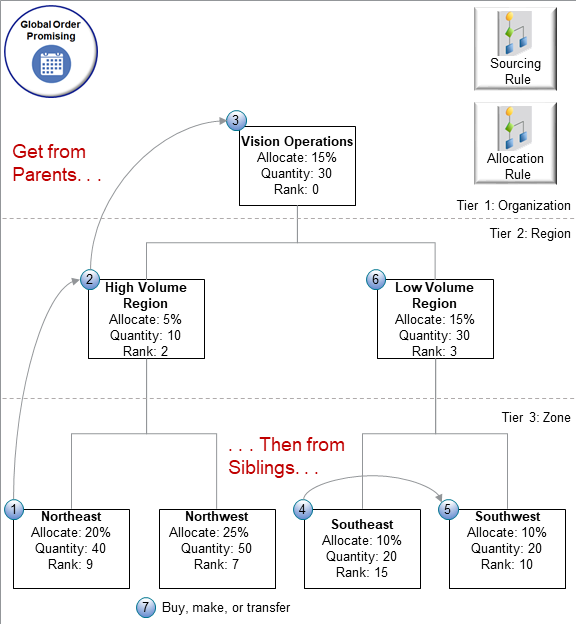Get Supply from a Node's Parents, and Then Its Siblings
You can rank your nodes so if a node's parents can't fulfill demand, then Promising gets supply from the node's siblings.
Assume you create a sales order and add an order that has the AS54888 computer with a quantity of 220.

Here's what Promising does.
| Step | Description | Remaining Balance |
|---|---|---|
| 1 | Consume all 40 units from Northeast. | 220 minus 40 equals 180. |
| 2 | Consume 10 units from High Volume. | 180 minus 10 equals 170. |
| 3 | Consume 30 from Vision Operations. | 170 minus 30 equals 140. |
| 4 | Consume 20 units from Southeast because its on the same tier as the Northeast node, and Southeast has the lowest rank of 15 on the zone tier. | 140 minus 20 equals 120. |
| 5 |
Consume 20 units from Southwest because its on the same tier as the Northeast node, and Southwest has the next lowest rank of 10 in the zone tier. Promising doesn't consume supply from Northwest because Northwest's rank is 7, which is lower than Northeast's rank of 9. |
120 minus 20 equals 100. |
| 6 |
Apply the same ranking logic on the next level up, the region tier. In this example, Promising consumes 30 units from Low Volume because its rank is 3, which is lower than High Volume's rank of 2. |
100 minus 30 equals 70. |
| 7 | Promising still needs 70 units, so it uses your ATP rules and sourcing rules to buy, make, or transfer them. | 70 minus 70 equals 0. |
To set this up, do the same work that you do in Get Supply from a Node's Parent, except you add a rank for each node.

For example:
| Node | Allocation Percentage | Rank |
|---|---|---|
| Vision Operations | 15 | 0 |
| High Volume Region | 10 | 2 |
| Low Volume Region | 15 | 9 |
| Northeast | 20 | 7 |
| Northwest | 25 | 3 |
| Southeast | 10 | 15 |
| Southwest | 10 | 10 |
Note that the rank doesn't have to be sequential. You can skip numbers. For example, this example doesn't have any nodes ranked at 8, 11, 12, 13, or 14. Promising will still use the ranking that you provide, where the lowest rank has the highest priority and the highest rank has the lowest priority. For example, Northwest's rank of 7 has a higher priority than Northeast's rank of 9.